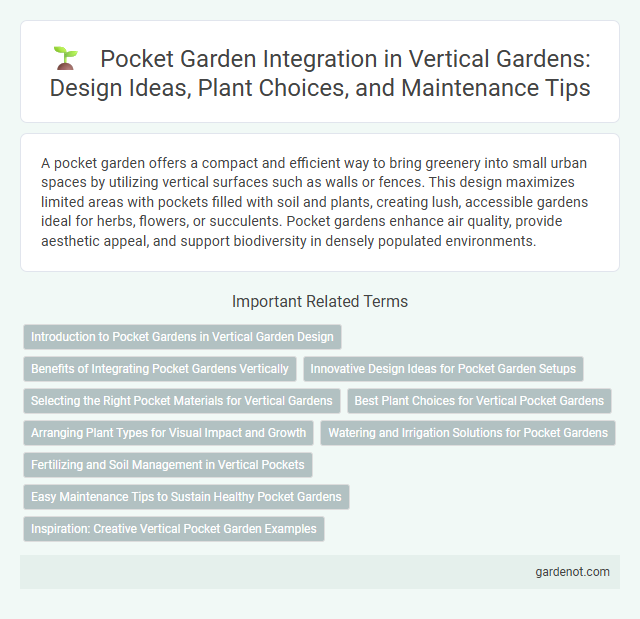A pocket garden offers a compact and efficient way to bring greenery into small urban spaces by utilizing vertical surfaces such as walls or fences. This design maximizes limited areas with pockets filled with soil and plants, creating lush, accessible gardens ideal for herbs, flowers, or succulents. Pocket gardens enhance air quality, provide aesthetic appeal, and support biodiversity in densely populated environments.
Introduction to Pocket Gardens in Vertical Garden Design
Pocket gardens in vertical garden design consist of fabric or felt pockets attached to a frame, allowing for efficient use of vertical space while supporting diverse plant species. These modular structures provide excellent drainage and aeration, promoting healthy root growth and reducing soil erosion. Ideal for small urban environments, pocket gardens enhance aesthetics and improve air quality by integrating greenery into compact areas.
Benefits of Integrating Pocket Gardens Vertically
Integrating pocket gardens vertically maximizes limited space, enhancing urban greenery without compromising floor area. These modular green walls improve air quality by filtering pollutants and increasing oxygen levels in indoor and outdoor environments. Vertical pocket gardens also provide thermal insulation, reducing energy costs and promoting biodiversity by supporting pollinators in dense urban settings.
Innovative Design Ideas for Pocket Garden Setups
Pocket garden setups showcase innovative design ideas by maximizing limited spaces with modular planting systems and vertical layering techniques, allowing for diverse plant arrangements in urban environments. Utilizing self-watering pockets and recycled materials enhances sustainability while supporting healthy plant growth. Incorporating smart irrigation sensors and customizable pocket configurations further optimizes space efficiency and maintenance ease for thriving mini ecosystems.
Selecting the Right Pocket Materials for Vertical Gardens
Selecting the right materials for pocket gardens in vertical installations is crucial for durability and plant health. Common options include felt, breathable fabrics, and recycled plastics, which provide adequate drainage and root aeration while supporting various plant types. Prioritizing lightweight, UV-resistant, and water-retentive materials enhances the garden's longevity and promotes optimal growth conditions in vertical environments.
Best Plant Choices for Vertical Pocket Gardens
Succulents, such as Echeveria and Sedum, thrive in vertical pocket gardens due to their low water needs and compact growth. Ferns like Boston fern and maidenhair fern provide lush greenery and adapt well to shaded vertical pockets. Herbs including basil, thyme, and mint offer both visual appeal and practical use, making them ideal for small vertical garden spaces.
Arranging Plant Types for Visual Impact and Growth
Arranging plant types in a pocket garden involves combining varied foliage textures and growth habits to maximize visual impact and health. Incorporate trailing plants like pothos or ivy at the top pockets for cascading effect, while placing compact, colorful plants such as succulents or herbs in lower pockets ensures balanced light distribution. Strategically mixing sun-loving and shade-tolerant species within the vertical layers promotes optimal growth and vibrant greenery.
Watering and Irrigation Solutions for Pocket Gardens
Pocket gardens benefit significantly from efficient watering and irrigation solutions designed to conserve water while promoting healthy plant growth. Drip irrigation systems and self-watering pockets reduce water waste by delivering moisture directly to the plant roots, enhancing nutrient absorption and minimizing evaporation. Automated timers and moisture sensors optimize watering schedules, ensuring consistent hydration tailored to the specific needs of pocket garden plants.
Fertilizing and Soil Management in Vertical Pockets
Vertical pocket gardens require nutrient-rich, well-draining soil enriched with organic compost to support healthy plant growth. Regular fertilization using balanced, slow-release fertilizers ensures consistent nutrient availability for plants in vertical pockets. Proper soil moisture retention can be maintained by incorporating materials like coconut coir or vermiculite, preventing root dryness and enhancing overall soil health.
Easy Maintenance Tips to Sustain Healthy Pocket Gardens
Pocket gardens thrive with well-drained soil, regular watering schedules, and balanced nutrient application using organic fertilizers. Pruning dead leaves and managing pests naturally with neem oil supports plant health and longevity. Choosing native plants reduces maintenance needs while promoting biodiversity within compact vertical garden spaces.
Inspiration: Creative Vertical Pocket Garden Examples
Pocket gardens transform small spaces into lush vertical landscapes, using modular pockets to cultivate herbs, succulents, and flowers efficiently. Creative examples include vibrant living walls with mixed plant varieties, integrating reclaimed materials like wooden pallets and fabric pockets for sustainable design. Innovative arrangements optimize light exposure and irrigation, inspiring urban gardeners to maximize green space in compact environments.
Pocket garden Infographic

 gardenot.com
gardenot.com